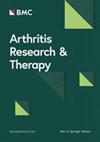Upadacitinib in active non-radiographic axial spondyloarthritis: 2-year data from the phase 3 SELECT-AXIS 2 study
IF 4.9
2区 医学
Q1 Medicine
引用次数: 0
Abstract
In SELECT-AXIS 2, upadacitinib improved the signs and symptoms of active non-radiographic axial spondyloarthritis (nr-axSpA) through 52 weeks versus placebo and was well tolerated. Here, we evaluated the efficacy and safety of upadacitinib through 2 years. The study enrolled eligible adult patients with a clinical diagnosis of nr-axSpA who met the 2009 Assessment of SpondyloArthritis international Society (ASAS) classification criteria and had objective signs of active inflammation on magnetic resonance imaging (MRI) of sacroiliac joints and/or high-sensitivity C-reactive protein. Patients were randomized 1:1 to receive double-blinded treatment with upadacitinib 15 mg once daily (QD) or placebo for 52 weeks, after which all patients received open-label treatment with upadacitinib 15 mg QD. Efficacy results over 104 weeks were reported as observed (AO) and either AO with non-responder imputation (AO-NRI; binary endpoints) or AO with mixed-effect model for repeated measures (continuous endpoints). Treatment-emergent adverse events (TEAEs) were summarized through week 104. Of 313 patients randomized and treated, 224 (continuous upadacitinib n = 117; placebo/upadacitinib n = 107) completed 104 weeks of treatment. In patients who received continuous upadacitinib, sustained improvement was observed through 2 years of treatment across efficacy endpoints including disease activity, pain, function, enthesitis, quality of life, and MRI measures of inflammation. At week 104, 57.1%, 59.0%, and 31.4% of patients achieved ASAS40 response, and low disease activity and inactive disease (as defined by Axial Spondyloarthritis Disease Activity Score), respectively (AO-NRI); week 104 outcomes were generally similar in patients who initially received placebo and were switched to upadacitinib at week 52. In total, 286 patients were exposed to ≥ 1 dose of upadacitinib, comprising 378.3 patient-years (PY) of exposure. Upadacitinib was generally well tolerated, with exposure-adjusted event rates (EAERs) for TEAEs, serious adverse events (AEs), and AEs leading to study drug discontinuation of 207.5, 8.7, and 5.3 events/100 PY, respectively. EAERs of TEAEs of special interest were broadly consistent with those reported through week 52. Treatment with upadacitinib demonstrated consistent improvement and maintenance of treatment effect across efficacy endpoints through 2 years; no new safety signals were identified with additional exposure. NCT04169373.Upadacitinib治疗活动性非影像学轴性脊柱性关节炎:来自3期SELECT-AXIS 2研究的2年数据
在SELECT-AXIS 2中,与安慰剂相比,upadacitinib在52周内改善了活动性非放射性轴性脊柱炎(nr-axSpA)的体征和症状,并且耐受性良好。在这里,我们通过2年的时间来评估upadacitinib的有效性和安全性。该研究招募了符合临床诊断为nr-axSpA的成年患者,符合2009年国际脊椎关节炎评估协会(ASAS)分类标准,骶髂关节磁共振成像(MRI)有活动性炎症的客观迹象和/或高灵敏度c反应蛋白。患者按1:1随机分组,接受upadacitinib 15mg每日一次(QD)或安慰剂双盲治疗52周,之后所有患者接受upadacitinib 15mg QD的开放标签治疗。超过104周的疗效结果报告为观察(AO)和AO与无反应推定(AO- nri;二元终点)或AO混合效应模型用于重复测量(连续终点)。对第104周的治疗不良事件(teae)进行总结。在313例随机接受治疗的患者中,224例(持续更新他替尼n = 117;安慰剂/upadacitinib (n = 107)完成了104周的治疗。在连续接受upadacitinib治疗的患者中,通过2年的治疗,观察到持续的改善,包括疾病活动性、疼痛、功能、炎症、生活质量和炎症的MRI测量。在第104周,57.1%、59.0%和31.4%的患者分别达到ASAS40反应、低疾病活动性和非活动性疾病(按轴性脊柱炎疾病活动性评分定义)(AO-NRI);第104周的结果与最初接受安慰剂并在第52周改用upadacitinib的患者大致相似。总共有286名患者暴露于≥1剂量的upadacitinib,包括378.3患者年(PY)的暴露。Upadacitinib总体耐受性良好,teae、严重不良事件(ae)和导致研究药物停药的ae的暴露调整事件率(EAERs)分别为207.5、8.7和5.3事件/100 PY。特别关注的teae的EAERs与第52周报告的EAERs大致一致。upadacitinib治疗在2年的疗效终点中表现出一致的改善和治疗效果的维持;额外的暴露没有发现新的安全信号。NCT04169373。
本文章由计算机程序翻译,如有差异,请以英文原文为准。
求助全文
约1分钟内获得全文
求助全文
来源期刊

Arthritis Research & Therapy
RHEUMATOLOGY-
CiteScore
8.60
自引率
2.00%
发文量
261
审稿时长
14 weeks
期刊介绍:
Established in 1999, Arthritis Research and Therapy is an international, open access, peer-reviewed journal, publishing original articles in the area of musculoskeletal research and therapy as well as, reviews, commentaries and reports. A major focus of the journal is on the immunologic processes leading to inflammation, damage and repair as they relate to autoimmune rheumatic and musculoskeletal conditions, and which inform the translation of this knowledge into advances in clinical care. Original basic, translational and clinical research is considered for publication along with results of early and late phase therapeutic trials, especially as they pertain to the underpinning science that informs clinical observations in interventional studies.
 求助内容:
求助内容: 应助结果提醒方式:
应助结果提醒方式:


